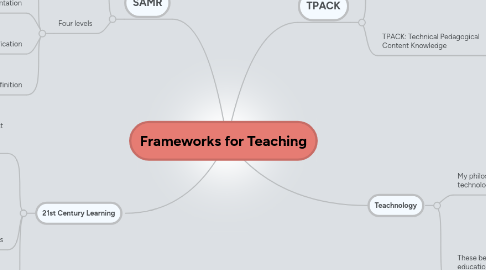
1. SAMR
1.1. A Method for seeing how computer technology might impact teaching and learning
1.2. Four levels
1.2.1. Substitution
1.2.1.1. No functional change in teaching and learning. Technology replaces a non technology material to complete a task
1.2.2. Augmentation
1.2.2.1. Some functional change in teaching and learning. Technology adds some measure of efficiency or benefit to task
1.2.3. Mocification
1.2.3.1. Significant functional change in teaching and learning: the task itself is accomplished through use of technology
1.2.4. Redefinition
1.2.4.1. Computer technology allows for tasks that were previously not possible. Produces new possibilities in teaching and learning
2. 21st Century Learning
2.1. 3 Ideas have emerged out of 21st Century Learning Thinkers and Organizations
2.1.1. Foundational Knowledge: Content, Information Literacy, Cross-Disciplinary Knowledge
2.1.2. Meta Knowledge: Critical Thinking, Problem Solving, Communication, Collaboration, Creativity
2.1.3. Humanistic Knowledge: Life/Job Skills, Cultural Competence, Ethical/Emotional Awareness
2.2. Some Key Organizations
2.2.1. Metiri Group
2.2.2. OECD: Organization for Economic Cooperation and Development
2.2.3. Partnership for 21st Century Skills
2.3. Some Key Thinkers
2.3.1. Howard Garner: Five Minds For the Future
2.3.2. Yong Zhao: Catching Up or Leading the Way
2.3.3. Daniel Pink: A Whole New Mind
3. TPACK
3.1. Consists of three spheres
3.1.1. TK: Technological Knowledge
3.1.2. PK: Pedagogical Knowledge
3.1.3. CK: Content Knowledge
3.2. TPACK: Technical Pedagogical Content Knowledge
3.2.1. TKP: Technological Pedagogical Knowledge
3.2.1.1. TK
3.2.1.2. PK
3.2.2. TCK: Technological Content Knowledge
3.2.2.1. TK
3.2.2.2. CK
3.2.3. PCK: Pedagogical Content Knowledge
3.2.3.1. PK
3.2.3.2. CK
4. Teachnology
4.1. My philosophy about the use of technology in teaching
4.1.1. Technology needs to be integrated into my teaching because the use of technololgy is integral to the professional working world. Students need to be educated to use technology in whatever they do
4.1.2. Students need to be educated on the elements of digital citizenship and positive digital footprint
4.1.3. Students need to be able to distinguish the use of technology for professional, educational, and learning settings and social settings
